Barcelona in 2 days
How to see Barcelona in just two days
Barcelona in two days: DAY 1
 9amLa Rambla
9amLa Rambla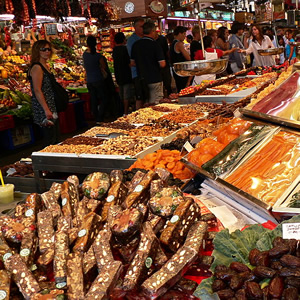 9:30amBoqueria market
9:30amBoqueria market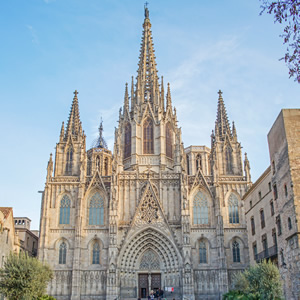 10:30amCathedral
10:30amCathedral 11:15amPicasso Museum
11:15amPicasso Museum 2pmAeri del Port
2pmAeri del Port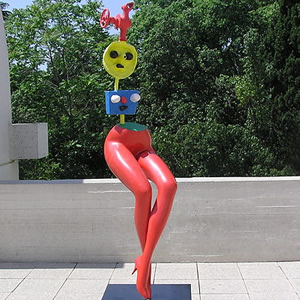 3pmMiró Museum
3pmMiró Museum 4pmMNAC
4pmMNAC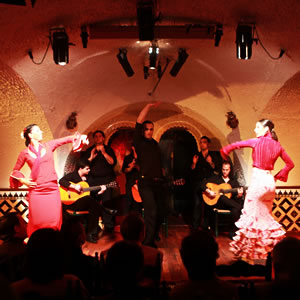 6:15pmFlamenco
6:15pmFlamenco
Morning: La Rambla and the Old City
Begin Day One at perhaps Barcelona’s greatest sight: La Rambla, that long, wide, pedestrian boulevard that glides right through the heart of the old city, from Plaça de Catalunya to the port.
9am: Start at the port end, at the Drassanes metro stop, perhaps with a quick ride to the top of the Columbus column for city and port views (20 minutes).
9:30am: Then just stroll up the boulevard, passing street performers and popping into La Boqueria market (45 minutes).
10:30am: Follow La Rambla all the way to Carrer de Portaferrisa and turn right until you get to the Gothic Catedral to explore (30 minutes).
11:15am: Then head over to the Museu Picasso for a marvelous collection of works by the Spanish master, including many early works he painted in a classical-style as a teenager, well before his discovery of Cubism (45 minutes).
Lunch
12:30: For lunch, work your way southwest through the back streets of the medieval Barri Gòtic to Los Caracoles for classic Catalan cuisine (75 minutes).
Afternoon: The sights of Montjuïc
2pm: Walk down to the harbor road, Passeig de Colom, and grab the No. 64 bus headed northest (left). It will take you out onto the Barceloneta peninsula, past the fishing town, to the teminus for the Aeri del Port cable car. Ride this scenic gondola over the harbor for great vistas of downtown Barcelona and up the Miramar on Montjuïc Hill (the ride is 7 minutes, but getting there will take 30 minutes).
3pm: Gab the no. 150 bus along Av. Miramar to the Fundació Joan Miró to see the work's of Barcelona's other towering Titan of twentieth-centuy art (45 minutes).
4pm: Turn right out of the Fundació Joan Miró and, right at the bus stop at teh end fo the property, look for the entance to the Jadrins de Laribal park. Stroll its paths, keeping a vaguely westerly direction to pop out onto Passeig de Santa Madrona. Turn right, and the road will shortly loop to the left and dposit you beside the Museu Nacional d’Art de Catalunya, filled with amazing Romaneque and Gothic art (90 minutes).
Evening: Flamenco and dinner
6pm: Have already booked tickets to the flamenco show and dinner at El Tablao de Carmen in the nearby Poble Espanyol. This is key, since a flamenco show ticket also gets you into (for free) the Poble Espanyol itself, an architectural theme park of re-created buildings from across Spain that now host craft workshops and artisan studios (in addition to restaurants, bars, and discos).
8:30pm: Aiming for the 6:15pm seating would make things a bit tight—and not allow you any time to enjoy shopping/strolling the workshops of the poble—so if you can handle one of those late Spanish dinnertimes, go for the 8:45pm seating (this will also give you more room in your afternoon schedule to take a bit more time at all the sights above).
Barcelona in two days: DAY 2
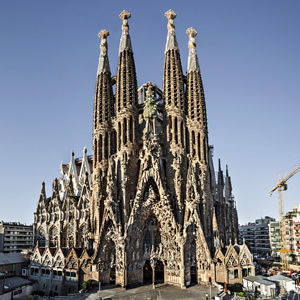 9amSagrada Familia
9amSagrada Familia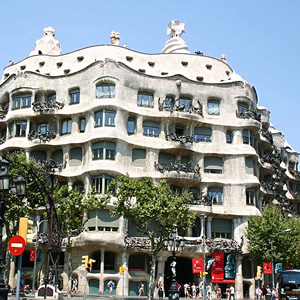 11amLa Pedrera
11amLa Pedrera NoonCasa Batlló
NoonCasa Batlló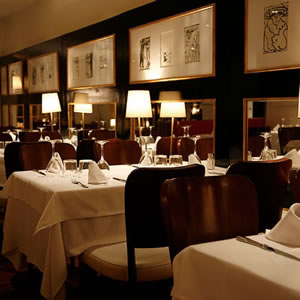 1pmLunch
1pmLunch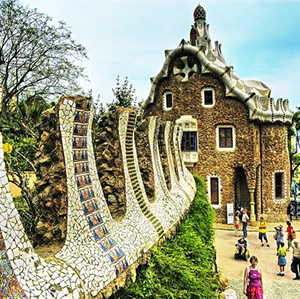 2:30pmPark Güell
2:30pmPark Güell 4pmLa Rambla
4pmLa Rambla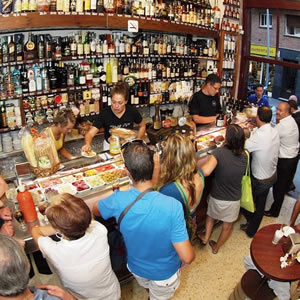 6pmTapas
6pmTapas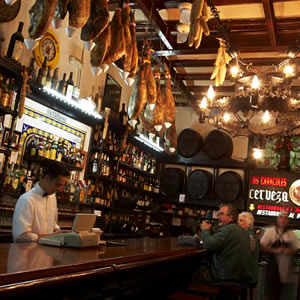 7pmDinner
7pmDinner
Morning: Modernisme in the New City
Day Two is the day for Modernisme, Barcelona's signature style of Art Nouveau architectures.
9am: Start at the only grand cathedral of Europe still in the midst of being built, Gaudí’s massive, drippy, sand castle of a church called the Sagrada Familia, a masterpiece-in-progress of Moderisme. Take the time to clamber around its spires and admire the whimsical sculpture adorning its odd hidden corners. (90 minutes)
11am: Then take the metro to Diagonal for more Modernisme masterpieces, starting with a tour of Gaudí’s Casa Milà "La Pedrera" (spend about 45 minutes in there).
Noon: Then proceed to the Art Nouveau wonderland of Passeig de Gràcia to stroll its famed Illa de la Discòrdia block, home to a string of Modernisme buildings. Take the walk and plenty pictures of the Casa Batlló (you can even go inside, if you have time for the hour-long audio tour) and other striking Art Nouveau structures. (45 minutes)
Lunch
1pm: You’re in luck that La Rita is just a block away from the Illa de la Discòrdia for lunch. (90 minutes)
Afternoon: Parks & relaxation
2:30pm: Now, because the last day-and-a-half have been pretty packed (and with lots of walking), take the afternoon to relax while still sightseeing. Head up to the Gaudí-designed Park Güell, a wonderful place to wander, full of whimsical architectural accents, plus the Casa-Museu Gaudí, where the master once lived. (90–120 minutes)
4:30pm: Spend the rest of the day relaxing on one of Barcelona's beaches, or strolling La Rambla some more before heading off for a tapeo, a stroll from tapas bar to tapas bar, nibbling your way through Catalan specialities and staving off that late, Spanish dinner time.
9pm: Dig into a well-deserved dinner—and a vow to return to Barcelona one day.
Tips & Links
If you're just passing through, I'd give Barcelona at least two full days, as outlined here.
It is a lovely place to relax, however, so you might be happier spending 3-4 days.
You may notice that—for example— on Day 2 I have you arriving at Sagrada Familia at 9am, spending 90 minutes there, but then not starting at the next stop (La Pedrera) until 11am.
No, my math is not wrong. I am simply allowing you the necessary time to get from place to place—walking, riding the Metro, walking some more—plus the inevitable time lost standing in ticket lines or waiting on a tour to start.
Whenever drawing up an itinerary, always leave time for the logistics.
Also, pad it with a bit extra for potential delays, unexpected discoveries along the way, or just for thsoe times when you find yourself delighted with something and end up spending longer there than originally planned.
SIGHTS
Barcelona tourist info: Barcelonaturisme.com (info office), Guiadelocio.com (events mag); Catalunya.com (regional info), Spain.info
Sightseeing passes: Barcelona Card (20+ sights; transport; discounts), Museum Pass (6 sights)
Tours & activities: Viator.com, ContextTravel.com, UrbanAdventures.com, City-Discovery.com, Intrepidtravel.com, Gadventures.com
LODGING
Hotels: Booking.com, Venere.com, Priceline.com, Hotels.com
B&Bs: Booking.com, Bedandbreakfast.com, Airbnb.com, Venere.com
Apartments: Rentalo.com, Vrbo.com, Booking.com, Airbnb.com, Interhomeusa.com, Homeaway.com
Hostels & campgrounds: Hostelbookers.com, Hostelworld.com, Hostelz.com, Booking.com
TRANSPORT
Airfares:
Airports: Aena.es
Trains: Raileurope.com (throughout Europe), Renfe.com (within Spain), Bahn.de (throughout Europe), Seat61.com
Public transport: Barcelona Card (free transport; sightseeing); Search all public transit: mou-te.gencat.cat; Metro/Bus: Tmb.cat; Tram: Trambcn.com; Light rail: Fgc.cat; Taxi: Taxibarcelona.cat
Car rentals: Autoeurope.com, RentalCars.com, Momondo.com, Orbitz.com, Expedia.com, Travelocity.com, Kayak.com
Barcelona has two types of sightseeing/transport passes:
There's a full description of both passes here, but in brief: The only museum covered fully by the Museum Pass that is not also covered by the Barcelona Card is the Museu Picasso (where you get only a 20% discount with the Barcelona Card).
You can also get discounts (usually 10% to 20%) on a wide range of sights, activites, and shows if you have a hop-on/hop-off bus ticket.
- Sightseeing
- Food & wine
- Day-trips
- Excursions
- Barcelona in One Day Sightseeing Tour
- Artistic Barcelona Afternoon Tour
- Barcelona Morning Sightseeing Tour
- Context: Welcome To Barcelona
- Skip the Line: Best of Barcelona Private Tour including Sagrada Familia
- Skip the Line: Barcelona Sagrada Familia Tour
- Context: Gaudi in Context
- Context: Gothic Quarter
- Barcelona Modernism and Gaudi Walking Tour
- Context: Dragon Hunt, Family Orientation to Barcelona
- Gaudí’s La Pedrera at Night: A Behind-Closed-Doors Tour in Barcelona
- Barcelona Super Saver: Montserrat Day Trip and Barcelona Gaudi Tour
- Barcelona Walking Tour: Picasso and Picasso Museum
- Context: Picasso's Barcelona
- Skip the Line: Best of Barcelona Private Tour including Sagrada Familia
- Gaudi's Park Güell Guided Walking Tour
- Skip-the-Line Barcelona Walking Tour: Palau de la Musica, Picasso Museum and Gaudi's Casa Batlló
- Context: Barcelona and the Sea
- Skip the Line: Gaudi's Casa Batlló Ticket with Audio Tour
- Context: Montjuic, Conquering the Mountain
- Context: Homage to Catalonia, the Spanish Civil War in Barcelona
- Barcelona Coastal Tour by Scooter
- Barcelona Gaudi Tour by Scooter
- Barcelona Photography Walking Tour: Walk Thru The Ages
- "The Shadow of the Wind" Walking Book Tour in Barcelona
- "The Cathedral of the Sea" Walking Book Tour in Barcelona
- Barcelona Gaudi Tour by Scooter
- Private Tour: Barcelona Half-Day Sightseeing Tour
- Private Tour: Barcelona Full-Day Sightseeing Tour
- Context: Custom Walk
- Context: City of Chocolate
- Tapas Evening Walking Tour of Barcelona
- Context: Modernista Menu: Avant-Garde Barcelona Cuisine
- Context: My Barcelona Kitchen
- Barcelona Tapas Tour “en el barrio”
- Context: Pica-Pica in Poble-Sec Tapas Walk
- Barcelona Cycle & Tapas
- Context: Farm to Fork, the Boqueria and Beyond
- Small-Group Tour: Traditional Food and Wine Day Trip from Barcelona
- Small-Group Cava and Wine Day Trip from Barcelona
- Sitges and Freixenet's Cava Wine Cellars Day Trip from Barcelona
- Barcelona Super Saver: City Tour, Sitges and Freixenet Cava Day Trip
- Barcelona Super Saver: Sitges, Freixenet Cava Wine Cellars and Montserrat Tour
- Catalan Culture Tour from Barcelona: Food Market, Montblanc and Human Tower Festival
- Barcelona Super Saver: Montserrat Day Trip and Barcelona Gaudi Tour
- Montserrat and Cava Trail Small Group Day Trip from Barcelona
- Three Countries in One Day: France, Andorra and Spain from Barcelona
- Girona, Figueres and Dali Museum Day Trip from Barcelona
- Montserrat Royal Basilica Half-Day Trip from Barcelona
- Barcelona and Montserrat Small-Group Tour
- Pyrenees Mountains Small Group Day Trip from Barcelona
- Salvador Dali Museum, Figueres and Cadaques Small Group Day Trip from Barcelona
- Small-Group Tour: Traditional Food and Wine Day Trip from Barcelona
- Small-Group Cava and Wine Day Trip from Barcelona
- Girona and Costa Brava Small Group Day Trip from Barcelona
- Barcelona Super Saver: Sightseeing Tour with Montjuic Cable Car and Montserrat Tour
- Barcelona Day Trip: Montserrat, Colonia Guell and Gaudi Crypt
- Barcelona Super Saver: City Tour, Sitges and Freixenet Cava Day Trip
- Barcelona Super Saver: Sitges, Freixenet Cava Wine Cellars and Montserrat Tour
- Sitges and Freixenet's Cava Wine Cellars Day Trip from Barcelona
- Tarragona and Sitges Small Group Day Trip from Barcelona
- Catalan Culture Tour from Barcelona: Food Market, Montblanc and Human Tower Festival
- Small-Group Medieval Villages Day Trip from Barcelona
- Private Tour: Salvador Dali Museum at Figueres and Girona Day Trip from Barcelona
- Private Full Day Tour to Sitges and Bodegas Torres
- 4-Day Best of Catalonia Tour from Barcelona
- 6-Day Spain Tour from Barcelona: Zaragoza, Madrid, Cordoba, Seville, Granada and Valencia
- 8-Day Spain Tour Including Barcelona, Madrid, Cordoba, Seville, Granada and Toledo
- 5-Day Spain Tour: Cordoba, Seville, Granada and Toledo from Barcelona
- 2-Day Northern Catalonia Tour: Vic, Figueres, Girona and Montserrat
- 2-Day Southern Catalonia Tour: Sitges, Tarragona and Santes Creus

Related Articles
This article was by Reid Bramblett and last updated in September 2013.
All information was accurate at the time.
Copyright © 1998–2013 by Reid Bramblett. Author: Reid Bramblett.
Barcelona tourist info: Barcelonaturisme.com (info office), Guiadelocio.com (events mag); Catalunya.com (regional info), Spain.info
Sightseeing passes: Barcelona Card (20+ sights; transport; discounts), Museum Pass (6 sights)
Tours & activities: Viator.com, ContextTravel.com, UrbanAdventures.com, City-Discovery.com, Intrepidtravel.com, Gadventures.com
LODGING
Hotels: Booking.com, Venere.com, Priceline.com
B&Bs: Booking.com, Bedandbreakfast.com, Airbnb.com, Venere.com
Apartments: Rentalo.com, Vrbo.com, Booking.com, Airbnb.com, Interhomeusa.com, Homeaway.com
Hostels & campgrounds: Hostelbookers.com, Hostelworld.com, Hostelz.com, Booking.com
TRANSPORT
Airfares:
Airports: Aena.es
Trains: Raileurope.com (throughout Europe), Renfe.com (within Spain), Bahn.de (throughout Europe), Seat61.com
Public transport: Barcelona Card (free transport; sightseeing); Search all public transit: mou-te.gencat.cat; Metro/Bus: Tmb.cat; Tram: Trambcn.com; Light rail: Fgc.cat; Taxi: Taxibarcelona.cat
Car rentals: Autoeurope.com, RentalCars.com, Momondo.com, Orbitz.com, Expedia.com, Travelocity.com, Kayak.com
